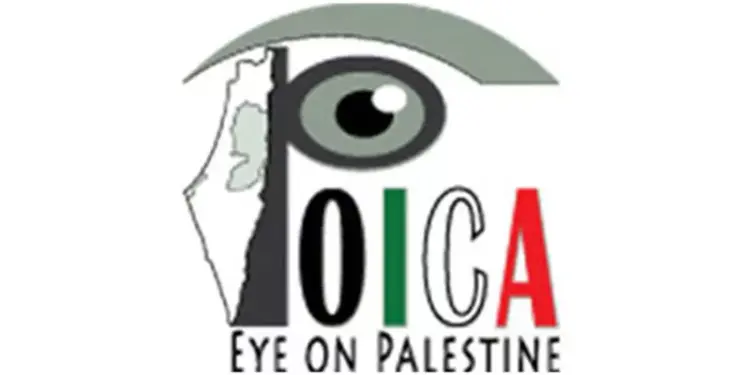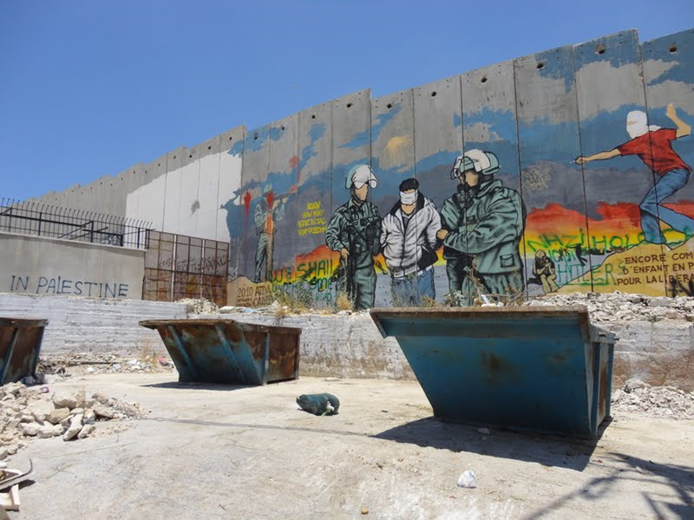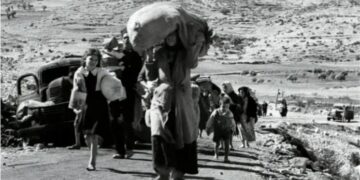Photograph taken of the wall in Aida Camp, Bethlehem
Source: photo taken by Ashley C. Overholser, ARIJ
International Court of Justice
Saturday, July 9, 2011 marks the 7
th anniversary of the International Court of Justice’s advisory opinion regarding the legal consequences of the construction of the wall in the occupied Palestinian territories. The International Court of Justice, the main judicial organ of the United Nations seated at the Peace Palace in The Hague, Netherlands, was established in 1945 by UN charter
The Court’s role is to settle, in accordance with international law, legal disputes submitted to it by States and to give advisory opinions on legal questions referred to it by authorized United Nations organs and specialized agencies.
The United Nations General Assembly, in December 2003, by means of resolution ES-10/14, urgently and officially requested that the International Court of Justice provide an advisory opinion based on the following question:
What are the legal consequences arising from the construction of the wall being built by Israel, the occupying Power, in the Occupied Palestinian Territory, including in and around East Jerusalem, as described in the report of the Secretary-General, considering the rules and principles of international law, including the Fourth Geneva Convention of 1949, and relevant Security Council and General Assembly resolutions?
A Call for Action
On July 9, 2004, the International Court of Justice, as one of the most respected, authoritative, legal bodies of the international community, determined that the construction of the wall is in violation of international law; in order to indicate the legal consequences of the construction of the wall, the Court had to first determine whether or not that wall breaches international law.
The Court then induced which rules and principles of international law are relevant in assessing the legality of the measures taken by the Israeli government, and furthermore examined the consequences of the violations by Israel of its international obligations by distinguishing between, on the one hand, those arising for Israel and, on the other, those arising for other States and, where appropriate, for the United Nations.
Finally, the Court concluded that the United Nations, and especially the General Assembly and the Security Council, should consider what further action is required to bring to an end the illegal situation resulting from the construction of the wall and the associated régime, taking due account the recommendations embedded within the present Advisory Opinion.
Subsequently, recommendations were voiced within the advisory opinion in the hopes to order Israel to stop the construction of the wall, to dismantle those sections already built, to provide reparations for all damages caused by their construction to the Palestinian people, and, finally, to cease all illegal occupying activities such as the demolition of homes, confiscation of land, and restriction of movement within the West Bank and East Jerusalem; furthermore, the Court placed emphasis on the fact that the wall acts as a physical, impeding force, not only in altering the demographic composition of the occupied Palestinian Territory but also in violating the Palestinian peoples’ right to self-determination.
Recognition from the international community is an immense achievement, even more so because of the fact that the advisory opinion was not requested by a Palestinian or Arab entity, but rather by a general consensus from the international community, as represented in the UN General Assembly
Last year, included in this brief, was not only a section on the background and legal findings of the 2004 ICJ advisory opinion, but also a section that outlines the current facts on the ground, which violate international law and continue to defy the 2004 ICJ findings. Indeed, these facts on the ground provided clear proof for how the Israeli government is continuing and reinforcing its regime of violations of the human rights of the Palestinian people
through the continuing construction of the Segregation Wall.
As you know, the advisory opinion was set to call for Israel to ‘cease forthwith the works of construction of the wall‘ and ‘to make reparation for all damages‘ and for the international community to ‘to recognize the illegal situation resulting from the construction of the wall‘, and finally for the General Assembly and the Security Council to ‘consider what further action is required to bring to an end the illegal situation resulting from the construction of the wall and associated regime‘. 8
As of last year, the ICJ’s ruling has been continually and consciously ignored by the Israeli government and the international community even though the Advisory Opinion is clear in its denouncing of the segregation wall, and clear in its call for Israel to dismantle the segregation wall and cease all illegal occupying activities.
However, as the seven year passes, there have been many new developments and attempts by the Palestinian people nationally to take further action in regards to the construction of the wall, one of which is the example of the recent dismantling of the wall in the Palestinian town of Bil’in.
On June 21, 2011 and four years after what is so-called “Israeli Supreme Court” decision to dismantle section from the Segregation Wall in Bil’in village west of Ramallah, which was considered Illegal according to the court decision issued in September 4, 2007, the Israeli Army started to dismantle the 2 km length electric fence- wall section in the western parts of the village. Accordingly, the village will regain 1200 out of 1968 dunums isolated behind the Wall path taking into account that the total area of the village is 4040 dunums. The new route which is set to replace the existing fence is 3.2 kilometers long where the Israeli Army supposed to finish dismantling the fence in the mid of July 2011.
July 1st, 2011–Palestinians celebrate last week’s moving of a portion of Israel’s West Bank segregation barrier in the village of Bilin, near Ramallah, Friday, July 1, 2011. The local residents on Friday began to construct buildings in the newly accessible land.
Source: Photo by: Oren Ziv/ Activestills.org
Bil’in village was one of the Palestinian villages and communities in the West Bank that had lost huge parts of its lands for the construction of the Apartheid Segregation Wall, where on April15, 2004, the Israeli Army issued the military order no. (40/04/T) for the confiscation of 384 dunums from Bil’in and the adjacent village of Safa lands for military purposes mainly for building the Segregation Wall.
The construction of the Segregation Wall in Bil’in village started in March 7, 2005 especially in the western parts of the village. In an analysis conducted by the GIS unit at the Applied Research Institute – Jerusalem (ARIJ), for the revised route of the Segregation Wall of April 2007, which was published at the website of the Israeli Ministry of Defense, Bil’in village had lost 1968 dunums (49%) of its lands behind the Segregation Wall path which stretches 2 km through the village lands dividing it into two parts and separates it from its agriculture lands located at the western parts of the village.
It is worth mentioning that on September 4, 2007, the Israeli Supreme Court had issued an order to reroute 1.7 km section of the Segregation Wall in Bil’in village within a distance of 500 meters away fr0m the village’s built-up area, where the court decision came as a result of a wave of petitions filed to the court by the residents of Bil’in along with its village council in demanding to rebuild it of the Green Line or westward, in addition of the Palestinian objections about the desperate living conditions caused by the construction of the Wall on their lands.
Regardless, the dismantling of the wall in Bil’in attests to the power of nonviolent resistance, and is a positive step towards peace. The will of the Palestinian people remains strong, the legal rights of the Palestinian people must be respected, and the Israeli government must begin to subsequently address issues of legality in regards to the construction and deconstruction of the wall in the Occupied Palestinian Territory. The Palestinian people are waiting for the United Nations to uphold their responsibilities as outlined in the UN Charter ‘to save future generations from the scourge of war’ and ‘to reaffirm faith in fundamental human rights, in the dignity and worth of the human person, in the equal rights of men and women and of nations large and small’
About the Israeli Segregation Wall
Upon completion, the Israeli Segregation Wall will extend across 774 Km in the West Bank; only 6.5%-51 km will run on the 1949 Armistice Line. The following table shows the status of the Segregation Wall in the West Bank: as of June 2011:
|
Status
|
Length/ Km
|
percentage
|
|
Existing
|
473
|
61
|
|
Under Construction
|
54
|
7
|
|
Planned
|
247
|
32
|
|
Total
|
774
|
100%
|
|
51 km (6.5% of the Wall’s total length) runs on the 1949 Armistice Line (Green Line)
|
It will annex behind it in the area between the Wall and the 1949 Armistice Line -AKA: Western Segregation Zone- 107 Israeli settlements, accommodating 80+% of the Israeli settlers’ population in the West Bank (more than 582000 Israeli settlers) and 66 Palestinian localities; including 30 in Jerusalem, from the West Bank. Moreover, the Segregation Wall will isolate within the western segregation zone 733 km² (733 thousands Dunums/ 73300 hectare), some 13% of the total area of the West Bank. The following table shows classification of isolated Palestinian land within the western Segregation zone:
|
Western Segregation Zone (733 km2) Land use/ Land cover
|
|
Item
|
Area/ km2
|
percentage
|
|
Agricultural Land
|
348
|
47.5
|
|
Israeli settlements & military bases
|
110
|
15
|
|
Forest and open space areas
|
250
|
34
|
|
Palestinian built-up area
|
25
|
3.5
|
|
Total
|
733 km2
|
100%
|
The effects of the Israeli plans (the isolation of the western Segregation zone) will cause severe adversities to the lives of thousands of Palestinians whose lives will be subjugated to the policies and control of the Israeli Army and evidently cutoff from their natural environment in the Occupied Palestinian Territory. In total 66 Palestinian localities (population 320,601) including 30 localities in Jerusalem (population 274,481) will be isolated from the West Bank by the Israeli Wall once the construction is completed.
On the seventh anniversary of the advisory opinion, ARIJ requests that the international community exert pressure on Israel to stop the construction of the Segregation Wall, but also praise attempts such as within the Palestinian town of Bal’in, to secure their rights. Furthermore, ARIJ requests that the international community advocates for the complete removal of the Wall from the OPT, as the continuing construction of the Segregation Wall violates fundamental human rights of the Palestinian people, including their inherent right to self-determination.
The Palestinian people have waited 7 years since the Advisory Opinion was issued, and sixty three years since they were expelled from their lands in 1948. How many future findings, opinions, rulings, or declarations need to be made before there is justice? The dismantling of the wall in Bil’in is one barrier that has been overcome—let us now tackles the other barriers inhibiting peace throughout the land through greater cooperation with the international community, abiding by the advisory opinion of the International Court of Justice and its rulings with hope for positive change.
2 cij.org/court/index.php?p1=1&PHPSESSID=bc2556f8aaf4b64ba9a00d539f00d710
3 International Court of Justice. “Legal Consequences-Summary of Advisory Opinion of 9 July 2004.” http://www.icj-cij.org/docket/files/131/1677.pdf
3International Court of Justice. “The Court.” http://www.icj-cij.org/court/index.php?p1=1&PHPSESSID=bc2556f8aaf4b64ba9a00d539f00d710
4 International Court of Justice. “Legal Consequences-Summary of Advisory Opinion of 9 July 2004.” http://www.icj-cij.org/docket/files/131/1677.pdf
4International Court of Justice. “The Court.” http://www.icj-cij.org/court/index.php?p1=1&PHPSESSID=bc2556f8aaf4b64ba9a00d539f00d710
4 International Court of Justice. “Legal Consequences-Summary of Advisory Opinion of 9 July 2004.” http://www.icj-cij.org/docket/files/131/1677.pdf
References
http://www.icjcij.org/court/index.php?p1=1&PHPSESSID=bc2556f8aaf4b64ba9a00d539f00d710
-
International Court of Justice. “Legal Consequences-Summary of AdvisoryOpinion of 9 July 2004.” http://www.icj-cij.org/docket/files/131/1677.pdf
-
United Nations General Assembly. “Illegal Israeli actions in Occupied East Jerusalemand the rest of the Occupied Palestinian Territory.” 12 December 2003.
Prepared by:













